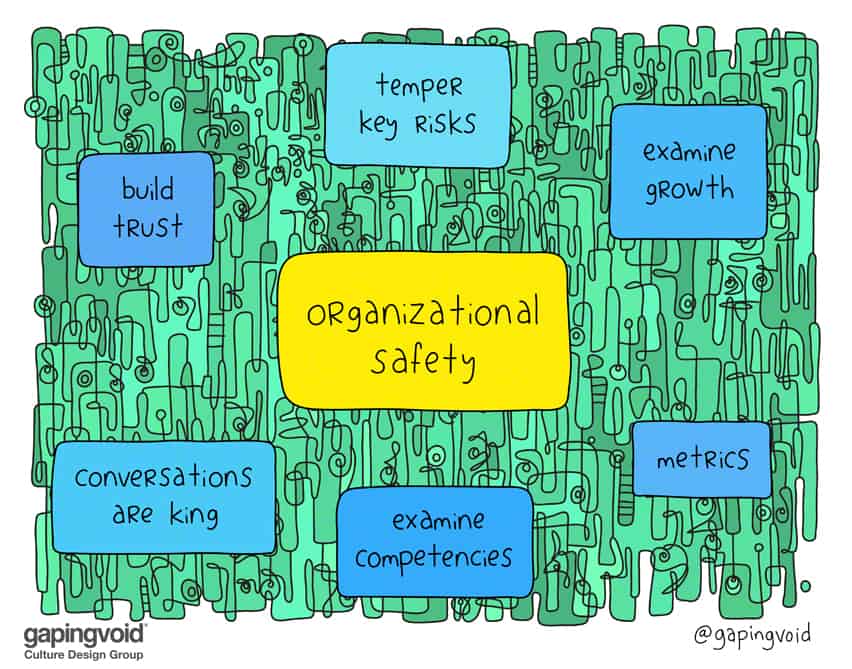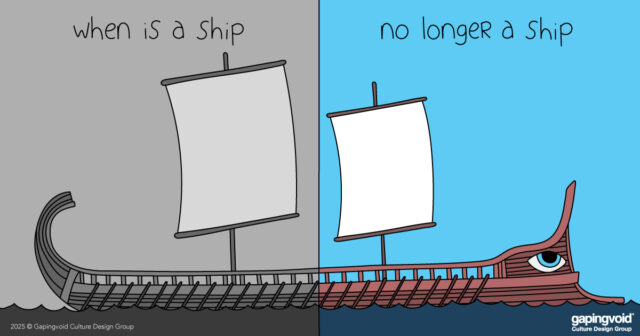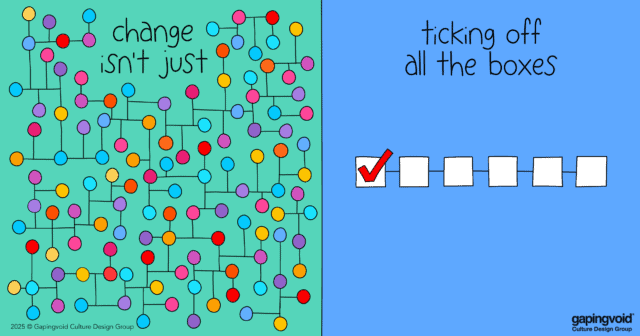
This is Marla Gottschalk’s first post on Gapingvoid. Marla has decades of experience as one of the leading I/O Psychologists in the country. Her love is organizational stability, and how we create a culture of psychological safety in the workplace. If you have had a Gapingvoid diagnostic done, Marla has been the brains behind it. We will soon be unveiling Marla’s take on the Adaptable, Resilient and Agile Culture Wall. We’ll be sharing some of her great thinking here. We encourage you to join the 2 million people following her on Linkedin
In this ever-changing world of work, I’m going to go out on the proverbial limb and vote for stability. Not the type of stability that shoots you in the foot and has the potential to signal an organizational downfall (resting on laurels, complacency, lack of customer connection). I’m speaking of the kind of internal stability that allows your organization’s engines to really rev and take flight. The kind of security borne of trust and understanding.
It is your organization’s cultural core.
The idea may sound a bit esoteric and difficult to grasp. Never the less, discussing its presence is vital. It is essential because great employees do not simply leave bad bosses — they run (where possible) from an unhealthy culture.
We have wrung our hands over various constructs that swirl around that core; engagement, turnover, commitment, loyalty. However, if we do not first take aim to affect our cultural core, forward progress is stymied.
Communication = Energy
One thing remains salient (at least from my perspective). You can’t positively affect your organization’s core without bringing your team along. There must be trust. There must be communication. There must be recognition that your people are your organization. How your traditions, mores and accepted processes affect them is critical. These collectively form your culture.
People provide the energy to start organizational engines. If the mission of your organization is misunderstood or mistranslated, your cultural core — so to speak — is weakened. Sometimes we simply forget people and we run ahead without them. We forget to ask, “are you still with us?” Or they were never on board, to begin with.
Same difference. We all lose.
We didn’t even bother to ask. Shame on us.
We must then circle back with great haste.
Creating Organizational Safety
This kind of stability demands open conversations about how the work is done, the goals and the direction we are traveling. It requires a conversation about growth and career. It also requires planning for the future (competency-wise) — even if that future is a tad fuzzy.
I would hypothesize that for the period time before great success or innovation, the organization was likely stable in some sense at the core — and this provides a sense of safety (ethical leadership, strong teams, adequate resources, etc.) It may seem that successes are borne from a Eureka moment — but there was likely a safe core there. People fully understood they were “culturally” safe, and they were free to seek excellence. Even with the existing whirlwind of activity around them in the external environment – that built stability was present.
Here are 6 elements to keep in mind when building out the core of your team or organization:
-
Build trust. Trust comes in many varieties and it needs to be attended to. Trust in leadership, communication and the potential to succeed — should be considered.
-
Temper key risks. How your employees view and process risk is an interesting cultural litmus test. When thinking of doing something remarkable or different, what goes through their minds? Excitement? Fear? Obstacles? This dynamic can limit an organizations ability to remain innovative.
-
Examine growth. Does your culture allow your employees to grow and reach across functional lines — or does it force contributors to protect their turf? Does the culture reward team players who help others thrive? Moreover, are ideas protected?
-
Conversations are king. You cannot align your team without exploring how they feel about their own aspirations and the environment in which they work. This starts with your core team and cascades throughout the organization.
-
Examine competencies. It’s really nonsense that the notion of competencies is dead for organizations. What’s dead is the idea that these areas of focus remain stagnant. What’s also dead it that we should use these as “hammers” to drive performance. Instead, they should reflect the strategy of an organization and translate into meaningful behaviors.
-
Metrics. Strengthening your core requires an organization to include a robust set of metrics. Many will be new markers of success. (Remember Marshall Goldsmith’s quote: “What got who here, won’t get you there”.) This also requires you to examine the drivers of those measures honestly.
From your perspective, how does an organization’s core affect work life? Share HERE.



